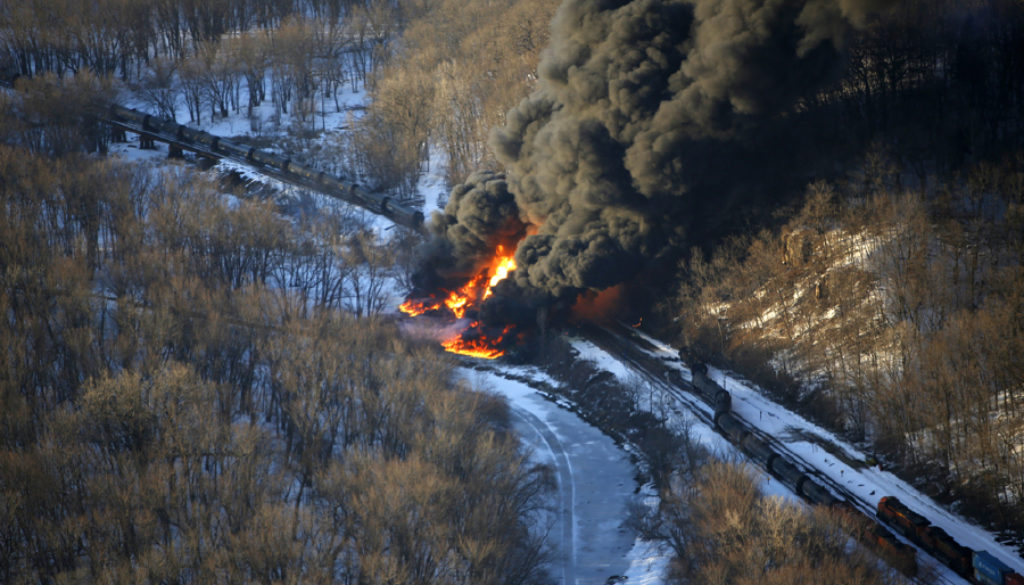A 300-Foot High Fireball from an Exploding Bakken Oil Train: When Will New Rail Safety Standards Be Approved?
By Amanda Frank, Policy Analyst, Citizen Health and Safety, Center for Effective Government

Sens. Maria Cantwell (D-WA) and Tammy Baldwin (D-WI) introduced legislation today that would create stronger crude-by-rail safeguards than those currently under review by the Office of Information and Regulatory Affairs. Among other things, the Cantwell-Baldwin bill would require the Pipeline and Hazardous Materials Safety Administration (PHMSA) to limit the volatile gases in crude oil that is transported by rail. The PHMSA and Federal Railroad Administration (FRA) rules currently under review require thicker tank car shells but do not regulate the crude itself, which is highly volatile and can explode during accidents.
The Cantwell-Baldwin bill would also ban certain classes of older tank cars, immediately removing 37,700 unsafe cars from use. It requires railroad companies to alert state and local emergency response officials when moving crude through communities and significantly increases fines for violations.
***
On Presidents’ Day, a train carrying volatile crude oil derailed in Fayette County, West Virginia, igniting several railcars and creating a fireball 300 feet high. While no one was seriously injured, the incident is a stark reminder of the need for stronger safeguards to protect communities near the tracks that transport crude oil.
A Disturbing Track Record
The derailed train was carrying crude oil from the Bakken oil fields in North Dakota to a refinery in Yorktown, Virginia. Bakken crude is highly volatile, and a derailment or other incident can cause massive explosions and fires. These trains routinely cross thousands of miles, passing through numerous towns and cities, including heavily populated downtown areas.
The Feb. 16 incident occurred about 30 miles southeast of Charleston, West Virginia. At least a dozen of the 109 cars derailed, setting fire to a house and causing more than 200 people to evacuate. One train car reportedly fell into the Kanawha River, polluting it with crude oil and igniting a fire on the surface of the water. Local authorities near the scene of the accident shut off river water intake valves and are testing municipal water for contamination.
We’ve seen other major accidents in several locations in just the past two years. Casselton, North Dakota experienced two derailments in less than a year, the most recent one occurring in November 2014. A July 2013 derailment in downtown Lac-Mégantic, Quebec killed 47 people and destroyed much of the town. And in 2014 alone, oil trains caused more than 140 spills.

Such scenes are becoming more likely as shipments of crude oil by rail increase. According to the nonprofit ForestEthics, oil train traffic has increased by 4,000 percent over the past five years. While some companies are shipping this oil in newer, supposedly safer railcars, the majority of trains still use outdated cars with serious safety flaws.
States Creating New Safeguards to Prevent Rail Explosions in the Face of Federal Inaction
Some states are taking action to improve the safety of crude oil trains.
In August 2014, California passed legislation requiring railroad companies to alert state emergency response officials about the movement of crude oil trains and to create emergency response plans. These rules apply to trains carrying more than 1 million gallons of hazardous substances, including, but not limited to, Bakken crude. Current federal rules only require companies to alert state officials when carrying Bakken crude.
Unfortunately, states have limited authority to regulate rail companies. They cannot issue speed limits or require trains to avoid large urban areas. Stronger safeguards will only come through federal action. Two agencies within the U.S. Department of Transportation have pending rules on oil-carrying trains.
The Pipeline and Hazardous Materials Safety Administration (PHMSA) and the Federal Railroad Administration (FRA) proposed rules in August 2014 to improve crude transport safety. These upgraded standards would establish speed limits and require rail companies to create emergency response plans. They would also require the phase-out of older DOT 111 tank cars and require tank car shells to be at least 9/16th of an inch thick. (The tank cars in the West Virginia accident were newer models, voluntarily adopted by the industry and considered safer than older models. But their shells are only 7/16th of an inch thick, meaning they would have to be retrofitted under the new rules.)
The agencies have already received public comments on these proposals, and a final rule is under review at the Office of Information and Regulatory Affairs.
Conclusion
While federal proposals are being finalized, existing oil train cars are accidents waiting to happen. But rail companies and oil companies don’t have to wait. They can act now and start moving toward implementing the standards that federal agencies are working to complete.
And citizens in at-risk communities can do more, too. Check out this interactive map by ForestEthics to see if your community is near a rail line that carries oil. Then ask local officials what the emergency plan is in the event of an accident and encourage the White House to approve the new transportation rules as soon as possible.

